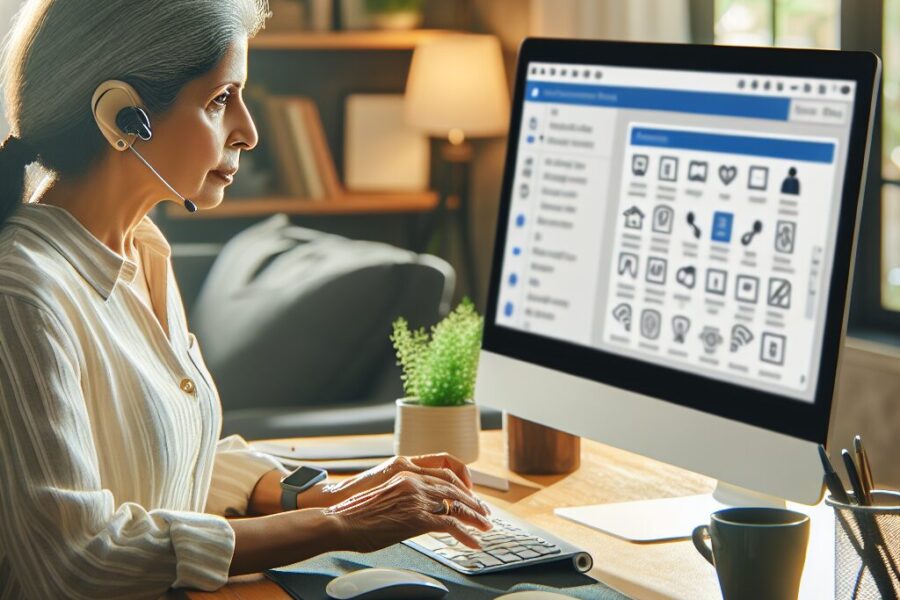

Accessibility is a Critical Piece of Any Customer Experience.
Accessibility ensures everyone – including those with disabilities – has equal access to vital information and services. Not only is accessibility a moral obligation to creating an inclusive society and a legal requirement for many government agencies and departments, it also makes good business sense.
The spending power of people with disabilities in the U.S. exceeds $200 billion annually. And as our population ages and the number of individuals with disabilities naturally increases, innovations in accessibility design will become even more crucial for this expanding market segment.
Companies that adapt their products and services to meet the needs of these individuals – like this recent progress in accessibility in the gaming industry – will find themselves at the forefront of a significant market opportunity. A 2022 Forrester Research report estimated that for every $1 spent on accessibility, a company would see an ROI of $100.
Additionally, in most cases, providing a better experience for people with disabilities also leads to an overall more user-friendly customer experience for all users, as well as improved search engine rankings.
For all these reasons, delivering inclusive and accessible experiences needs to be a critical part of all customer experience strategies. But how do you ensure your CX is in fact accessible?
What is Accessibility?
Accessibility is a word most of us understand, especially when thinking about buildings. But accessibility is about far more than just wheelchair ramps and ADA-approved door handles. When we’re looking at the digital aspects of a customer experience, accessibility can be divided into four categories – auditory, visual, mobility, and cognitive needs.
Here are two examples for each of those categories to help ensure your CX is accessible.
AUDITORY NEEDS
- Closed Captioning: Provide text alternatives for audio content, including closed captions for videos.
- Transcripts: Offer transcripts for audio-only content like podcasts or audio files.
VISUAL NEEDS
- Screen Readers: Ensure compatibility with screen readers that convert text to speech.
- High Contrast Modes: Offer high contrast modes and text resizing options.
MOBILITY NEEDS
- Keyboard Navigation: Ensure websites and applications can be fully navigated and operated using a keyboard or alternative input devices.
- Touchscreen Accessibility: Design touchscreen interfaces that are accessible for users with dexterity challenges.
COGNITIVE NEEDS
- Focus Cues: Leverage clear visual cues to indicate interactive elements and current focus.
- Simple Language: Use clear, simple language and avoid complex jargon or idioms.
Is Your CX Accessible?
By simply remembering to focus on accessibility and follow the simple tips listed above, you will dramatically improve the accessibility of your customer experience. But to truly ensure accessibility, you should audit your entire CX.
THREE-PHASE AUDIT
Because both fully-automated and fully-manual testing of any sort – including accessibility – have advantages and disadvantages, we recommend a three-phase approach that combines both automated and manual components.
Phase 1: Automated Testing
As the first-phase, these automated tests will help develop a solid understanding of your current level of accessibility, setting the stage for enhancement.
The main activities and outcomes of these automated tests include:
- Identifying accessibility barriers.
- Pinpointing accessibility issues.
- Mapping current accessibility processes.
- Understanding stakeholder needs.
Some of the AI-enabled tools used to conduct this phase include WAVE Accessibility, UserWay’s AI-Powered Compliance, and Lighthouse for Automated Accessibility. All three of these tools are powerful ways to start an accessibility audit, but by themselves, without human testing, they have limitations.
Automated testing tools don’t always catch real-world effectiveness of layout and color, often underappreciate how a person with disabilities can successfully navigate a site that includes commonly used UX tactics, and simply isn’t able to experience a site or application like a human does.
The deliverable of this phase is the start of your thorough audit and will be a comprehensive report of accessibility gaps with recommendations for improvement.
Phase 2: Manual Accessibility Testing
To go beyond automated testing, human testers will gain comprehensive insights into the practical challenges facing users with disabilities. This phase will enrich the understanding of accessibility beyond what the automated tests tell us.
The main activities and outcomes of these manual tests include:
- Uncovering accessibility issues.
- Determining compliance with WCAG (Web Content Accessibility Guidelines).
- Assessing navigational structures, keyboard accessibility, and compatibility with assistive technologies.
Through this phase, you will gain a detailed report identifying complex accessibility barriers and specific instances of non-compliance, as well as actionable recommendations to enhance usability and accessibility.
Phase 3: Automated Testing with Manual Verification
This final phase combines the thoroughness of automated testing with the nuanced interpretation of human testing to ensure the highest level of accessibility.
The main activities and outcomes of this phase include:
- Identifying issues at scale.
- Verifying, interpreting, or refuting automated findings with human testing.
At the end of this phase, you will have a comprehensive overview of accessibility compliance and areas for improvement.
While we just described how this three-phase audit should be used to determine the accessibility of your CX in its current state, the same testing concepts and protocols should also be used during and after development and deployment of all enhancements or updates to any aspects of your customer experience.
Accessibility is a Crucial Piece of a True CX Transformation
Accessibility, on its own, is important to ensure you’re serving everyone in your audience, but accessibility isn’t something we should think of on its own. Accessibility is a key component of your customer experience, and therefore, should be integrated into any CX Transformation.
A clear example of this integration was the work we did with the Ohio Bureau of Workers Compensation. Through this CX Transformation, we studied and addressed all components of the BWC’s citizen experience.
Specifically, we worked to ensure the creation of an empathetic and personal experience that all users would be able to easily navigate. And to do so, we incorporated accessibility testing and compliance into every step of the process.
Let’s Make Sure Your CX is Accessible to Everyone.
Delivering an accessible digital experience for all users – including those with disabilities – is both a social responsibility and a strategic business decision.
If you’re ready to ensure your customer experience is accessible to all users, please reach out to discuss how an accessibility audit should be one of the first steps in transforming your customer or citizen experience into one that is compliant, engaging, and inclusive to everyone with whom your organization engages and wishes to engage.